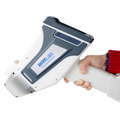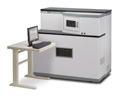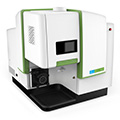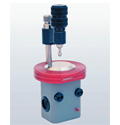Spectroscopy Spotlight
Metals and metalloids, while essential to some living organisms, can, in high concentrations, be toxic. An understanding of how these metals and metalloids are accumulated and transported within plants and animals is possible with the use of synchrotron X-ray fluorescence (SXRF) microtomography. The technique is used in the imaging of major and trace element distributions within natural materials, nondestructively, and with high spatial resolution. Stefan Vogt of the Argonne National Laboratory in Lemont, Illinois, has been exploring the use of SXRF to detect metal content in biological and other systems. He recently discussed the various challenges, applications, and advantages associated with this technique. read more
|
|
|
Subscribe Subscribers can enjoy each full issue of Spectroscopy in print, or via Spectroscopy apps.
subscription offers
|

|
|
|
|
advertisment
Choose the Thermo Scientific™ EA IsoLink™ IRMS System for CNSOH elemental and isotopic determination, from low µg to high mg, whether you perform state of the art research or routine analyses in ecology, geosciences, food authenticity or forensics. Ultimate precision and higher sample throughput are delivered using temperature ramped GC alongside very low helium consumption and complete software automation.
Learn more 
|
|
|
Quiz
This quiz is a regular feature of the “IR Spectral Interpretation Workshop” column. In each installment, we present a quiz. The answers appear in the subsequent installment. read more
advertisment
ICDD's PDF-4+ 2016 database is designed for both phase identification and quantitative analysis. It provides comprehensive material coverage for inorganic materials with 384,613 entries. PDF-4+ supports automated quantitative analyses by providing key reference data, including digital patterns for use in total pattern analysis; entries with I/Ic values for quantitative analysis by Reference Intensity Ratio; and, entries with access to atomic coordinates sets for quantitative analysis by Rietveld method.
 Learn more Learn more
|
|
Featured News
At SciX 2016 in Minneapolis, Minnesota, the Society for Applied Spectroscopy sponsored the special session "Analytical Chemists Easing World Poverty." This session was founded in 2011 by SAS Past-President Diane Parry to highlight unmet measurement needs in developing nations. With the support of sponsors like the SAS, Spectroscopy magazine, and ChromAfrica, it has evolved into a popular session that examines a variety of topics ranging from technical solutions to instrumentation problems to cultural challenges of Westerners working in developing nations. read more
advertisment
In this executive summary, we will discuss how triple-quadrupole ICP-MS resolves interferences and improves accuracy for difficult elements and challenging applications.
 Download Executive Summary >> Download Executive Summary >>
|
|
|
FEATURED ARTICLES
Using this method, complete elemental recovery and removal of organic matrices can be achieved safely and up to 57 elements can be determined in oils with good accuracy and precision. The removal of organic matrices during digestion helps limit the formation of polyatomic spectral interferences and also improves instrument stability. read more
Many developments in the miniaturization of analytical instruments have enabled metal detection at extremely low concentrations, using techniques such as XRF, LIBS, and laser-ablation resonance ionization mass spectrometry (LA-RIMS). These new technologies are facilitating advances in areas such as space exploration, environmental studies, and pharmaceutical analysis. read more
The authors compare LC–MS/MS methods for quantification of the pesticide glyphosate with and without sample derivatization, and discuss ICP-MS methods for the determination of heavy metals. read more
|
|
|
FEATURED PRODUCTS
 |
The NanoLIBS is an award winning handheld elemental analyzer for rapid identification and verification of raw materials including ionic salts in both the lab and field!
 Learn more
Learn more
|
 |
This performance note highlights the GDS850As unique depth profiling algorithm, which adjusts for differences in sputtering rates of different materials, enabling accurate measurement of depth without an added costly accessory.
 Learn more Learn more
|
 |
PerkinElmer's all-new Avio 200, the smallest ICP-OES on the market, is capable of handling the most difficult high-matrix samples without dilution, for a whole new level of performance and flexibility. Watch the video.
 Learn more Learn more
|
 |
Harrick's DiaMaxATR single-reflection diamond attenuated total reflectance accessory is designed to enable simplified analysis of a range of sample types, including hard solids, abrasive powders, and corrosive liquids.According ti the company, available options include far-IR extended sampling, a digital force sensor,and heated flow cells.
Harrick Scientific products, Inc.,
Pleasantville, NY;
 www.harricksci.com www.harricksci.com
|
|
|
|
NEW WEBCAST
European Broadcast: Tuesday, November 29, 2016
2 pm GMT | 3 pm CET
US Broadcast: Tuesday, November 29, 2016
11 am EST | 8 am PST | 10 am CST
|
|
|
|
|
|